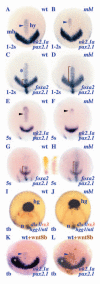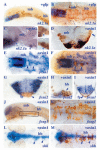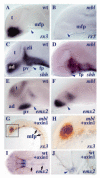Inhibition of Wnt/Axin/beta-catenin pathway activity promotes ventral CNS midline tissue to adopt hypothalamic rather than floorplate identity
- PMID: 15539488
- PMCID: PMC2789262
- DOI: 10.1242/dev.01453
Inhibition of Wnt/Axin/beta-catenin pathway activity promotes ventral CNS midline tissue to adopt hypothalamic rather than floorplate identity
Abstract
Ventral midline cells in the neural tube form floorplate throughout most of the central nervous system (CNS) but in the anterior forebrain, they differentiate with hypothalamic identity. The signalling pathways responsible for subdivision of midline neural tissue into hypothalamic and floorplate domains are uncertain, and in this study, we have explored the role of the Wnt/Axin/beta-catenin pathway in this process. This pathway has been implicated in anteroposterior regionalisation of the dorsal neural tube but its role in patterning ventral midline tissue has not been rigorously assessed. We find that masterblind zebrafish embryos that carry a mutation in Axin1, an intracellular negative regulator of Wnt pathway activity, show an expansion of prospective floorplate coupled with a reduction of prospective hypothalamic tissue. Complementing this observation, transplantation of cells overexpressing axin1 into the prospective floorplate leads to induction of hypothalamic gene expression and suppression of floorplate marker gene expression. Axin1 is more efficient at inducing hypothalamic markers than several other Wnt pathway antagonists, and we present data suggesting that this may be due to an ability to promote Nodal signalling in addition to suppressing Wnt activity. Indeed, extracellular Wnt antagonists can promote hypothalamic gene expression when co-expressed with a modified form of Madh2 that activates Nodal signalling. These results suggest that Nodal signalling promotes the ability of cells to incorporate into ventral midline tissue, and within this tissue, antagonism of Wnt signalling promotes the acquisition of hypothalamic identity. Wnt signalling also affects patterning within the hypothalamus, suggesting that this pathway is involved in both the initial anteroposterior subdivision of ventral CNS midline fates and in the subsequent regionalisation of the hypothalamus. We suggest that by regulating the response of midline cells to signals that induce ventral fates, Axin1 and other modulators of Wnt pathway activity provide a mechanism by which cells can integrate dorsoventral and anteroposterior patterning information.
Figures






Similar articles
-
Direct action of the nodal-related signal cyclops in induction of sonic hedgehog in the ventral midline of the CNS.Development. 2000 Sep;127(18):3889-97. doi: 10.1242/dev.127.18.3889. Development. 2000. PMID: 10952887
-
Ectopic Wnt signal determines the eyeless phenotype of zebrafish masterblind mutant.Development. 2001 Oct;128(20):3877-88. doi: 10.1242/dev.128.20.3877. Development. 2001. PMID: 11641213
-
Relationship of vegetal cortical dorsal factors in the Xenopus egg with the Wnt/beta-catenin signaling pathway.Mech Dev. 1999 Dec;89(1-2):93-102. doi: 10.1016/s0925-4773(99)00210-5. Mech Dev. 1999. PMID: 10559484
-
TCF: Lady Justice casting the final verdict on the outcome of Wnt signalling.Biol Chem. 2002 Feb;383(2):255-61. doi: 10.1515/BC.2002.027. Biol Chem. 2002. PMID: 11934263 Review.
-
New steps in the Wnt/beta-catenin signal transduction pathway.Recent Prog Horm Res. 2000;55:225-36. Recent Prog Horm Res. 2000. PMID: 11036939 Review.
Cited by
-
Feed your head: neurodevelopmental control of feeding and metabolism.Annu Rev Physiol. 2014;76:197-223. doi: 10.1146/annurev-physiol-021113-170347. Epub 2013 Nov 18. Annu Rev Physiol. 2014. PMID: 24274739 Free PMC article. Review.
-
Rx3 and Shh direct anisotropic growth and specification in the zebrafish tuberal/anterior hypothalamus.Development. 2016 Jul 15;143(14):2651-63. doi: 10.1242/dev.138305. Epub 2016 Jun 17. Development. 2016. PMID: 27317806 Free PMC article.
-
Lhx5 controls mamillary differentiation in the developing hypothalamus of the mouse.Front Neuroanat. 2015 Aug 14;9:113. doi: 10.3389/fnana.2015.00113. eCollection 2015. Front Neuroanat. 2015. PMID: 26321924 Free PMC article.
-
Scalable Hypothalamic Arcuate Neuron Differentiation from Human Pluripotent Stem Cells Suitable for Modeling Metabolic and Reproductive Disorders.bioRxiv [Preprint]. 2024 Sep 20:2024.06.27.601062. doi: 10.1101/2024.06.27.601062. bioRxiv. 2024. PMID: 39005353 Free PMC article. Preprint.
-
Canonical Wnt signaling is required for the maintenance of dorsal retinal identity.Development. 2008 Dec;135(24):4101-11. doi: 10.1242/dev.027367. Epub 2008 Nov 12. Development. 2008. PMID: 19004855 Free PMC article.
References
-
- Agathon A, Thisse C, Thisse B. The molecular nature of the zebrafish tail organizer. Nature. 2003;424:448–452. - PubMed
-
- Amacher SL, Draper BW, Summers BR, Kimmel CB. The zebrafish T-box genes no tail and spadetail are required for development of trunk and tail mesoderm and medial floor plate. Development. 2002;129:3311–3323. - PubMed
-
- Barth KA, Wilson SW. Expression of zebrafish nk2.2 is influenced by sonic hedgehog/vertebrate hedgehog-1 and demarcates a zone of neuronal differentiation in the embryonic forebrain. Development. 1995;121:1755–1768. - PubMed
-
- Barth KA, Kishimoto Y, Rohr K, Seydler C, Schulte-Merker S, Wilson SW. Bmp activity establishes a gradient of positional information throughout the entire neural plate. Development. 1999;126:4977–4987. - PubMed
Publication types
MeSH terms
Substances
Grants and funding
LinkOut - more resources
Full Text Sources
Molecular Biology Databases

